#William Blake's Illustrations of the Book of Job
Text










It's Fine Press Friday!
Today we’re taking a closer look at our sister set of editions from Trianon Press: William Blake's Illustrations of the book of Job : the engravings and related material and Colour versions of William Blake's Book of Job designs, both of which were published in 1987 in London by the William Blake Trust.
The former edition includes two volumes of original black and white illustrations and facsimiles, process prints which document the evolution of the final product, and essays. It was edited by David Bindman (b. 1940) and includes plate-by-plate commentary and an introduction by Bo Lindberg (1937-2021), whose Ph.D. thesis on the work was published in 1973.
The latter includes three sets of color plates- The New Zealand set, The Collins set, and the Fitzwilliam plates- all of which were reproduced in facsimile from the original engravings, which were published in 1826. The New Zealand set are finished watercolor drawings, while the Collins and Fitzwilliams sets are hand-colored collotype reproductions (using the pochoir method) of the published engravings. All told the set includes 22 fascicules containing the title page and accompanying texts and 46 plates of illustrations measuring from 40-41 cm., all housed in marbled portfolios nested in leather-bound slipcases.
Can’t get enough of these books? Check out Alice’s Marbled Mondays post on their beautiful bindings. And check out UCSC Library’s digital exhibition Songs of Labor and Transcendence: The Trianon Press Archive for more on the history and legacy of the Trianon Press.
--Ana, Special Collections Graduate Intern
View more Fine Press Fridays posts
View more William Blake posts
View more Trianon Press posts
#Fine Press Fridays#William Blake#Trianon Press#pochoir#collotype#David Bindman#Bo Lindberg#Book of Job#William Blake's Illustrations of the Book of Job#engravings#Ana
36 notes
·
View notes
Text
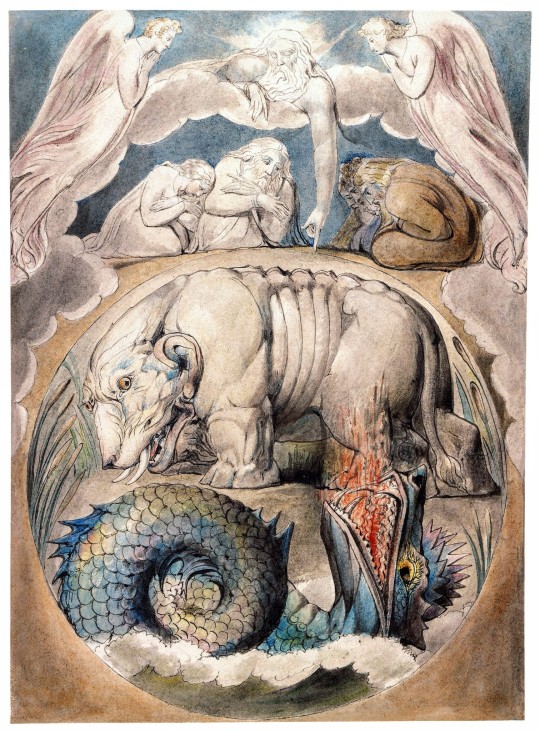
Behemoth and Leviathan (1806) by William Blake; a preliminary watercolor for Illustrations of the Book of Job.
#william blake#best checkers buddy in the world#beast#art#painting#monster#horror#book of job#mythology#english literature#god#bible#surreal#watercolor#animals#illustration#books & libraries#spirituality#lit#art history#👽
748 notes
·
View notes
Text
William Blake - an introduction for Good Omens fans
I have sent @neil-gaiman an ask regarding his feelings toward the poet/artist William Blake a couple of times, but no doubt due to the size of the poor man's inbox I haven't received a response. So I did a Google search to see if he's spoken about Blake before, and it did indeed come up with a fair few hits. I think you might enjoy seeing this Twitter post if you haven't already, the painting is from William Blake's illustrations to Paradise Lost.
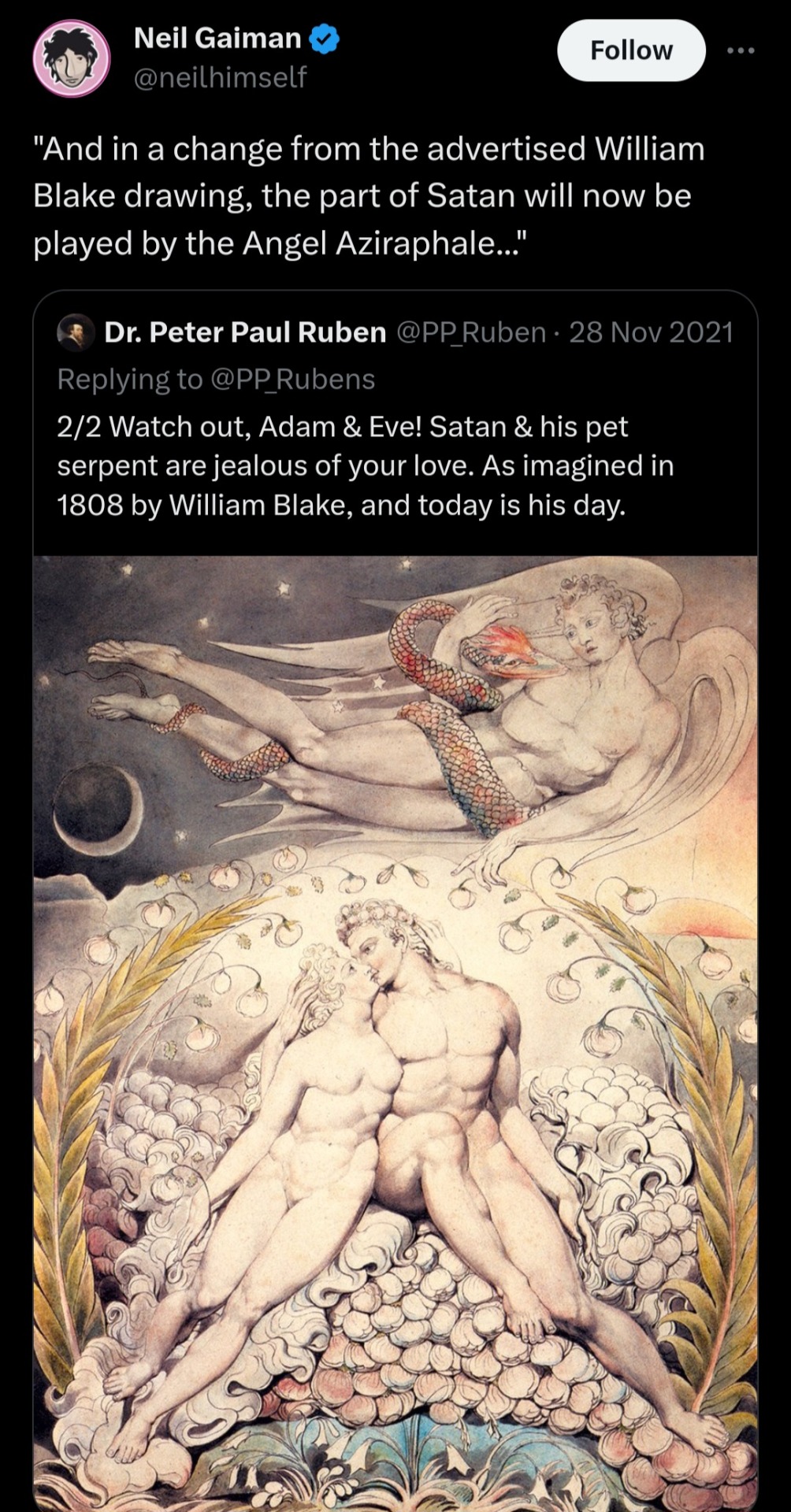
It's not surprising that an author like Neil Gaiman might have an interest in Blake. A visionary from a young age, his imagination was such that he was surrounded by angels made visible in his mind's eye, and he interpreted these visions through poetry, painting and engraving, and self-printed and published many of his own works. This gave him complete freedom to say exactly what he wanted.
Though he had a passionate faith in God, he also had a deep distrust of the church as an institution, and disliked the use of religion as a means of control. This poem from "Songs of Experience" perhaps summarises his feelings best:
"I went to the Garden of Love,
And saw what I never had seen:
A Chapel was built in the midst,
Where I used to play on the green.
And the gates of this Chapel were shut,
And 'Thou shalt not' writ over the door;
So I turn'd to the Garden of Love,
That so many sweet flowers bore.
And I saw it was filled with graves,
And tomb-stones where flowers should be:
And Priests in black gowns, were walking their rounds,
And binding with briars, my joys & desires."
In his poetry there is often an incongruity with the generally accepted religious ideas of what is good and evil, Angel and Demon. In The Marriage of Heaven and Hell (there's a title that should make any GO fan sit up and pay attention) he tells us that "in the book of Job, Milton's Messiah is called Satan", signifying that he feels it is Lucifer/the devil who is the true Messiah of Paradise Lost.
He gives us The Voice of the Devil and Proverbs of Hell, and has Angels being transformed into Demons through enlightenment. He tells us that Jesus broke all of the 10 commandments, yet was still virtuous because he acted according to his own morality rather than rules.
The god-figure of his later works, Urizen, generally comes across as malevolent, seeking to bind and control, whilst Los, the Satan/Messiah figure represents freedom, imagination and creativity.
"Restraining desire" and acting contrary to your own nature seem to be the only real evils for Blake.
He expressed his faith through a love of the world and the beauty in it, summed up in this quote:
"When the Sun rises do you not see a round Disk of fire somewhat like a Guinea? O no no I see an innumerable company of the Heavenly host crying Holy Holy Holy is the Lord God Almighty".
He saw "God" in everything, in all the wonders we have around us, and considered writers/poets and religious prophets as essentially the same, since they both have a connection to the divine, and express it through stories.
It's quite ironic that probably his most famous poem, Jerusalem (the one that starts "and did those feet in ancient times walk upon England's mountains green"), was made into a very popular church hymn, yet it is supposed to be satirical in nature. The poem recounts the myth that Jesus may have visited England in his boyhood, and Blake is expressing his disbelief at that notion and the unworthiness of England.
Did I have a point to all this? Mostly to show my hand as a massive Blake nerd, but also to hopefully demonstrate that there's a lot of common ground between his ideas and those expressed in a show/book like Good Omens, and hopefully to inspire some of you who may not be familiar with Blake to seek him out. In particular I'd recommend The Marriage of Heaven and Hell to any and all.
EDIT: I should have thought to include this, here's Michael Sheen reading a Blake poem. I have the CD this is from, he reads several by Blake, as well as other poets I love ❤️ 😍
youtube
#william blake#good omens#good omens book#good omens 2#good omens s3#neil gaiman#crowley#aziraphale#english literature#literature#poetry#go2#good omens s2#good omens season 2#book omens#michael sheen#Youtube
1K notes
·
View notes
Text

Illustration to Book of Job painted by William Blake (1757 - 1827)
122 notes
·
View notes
Text
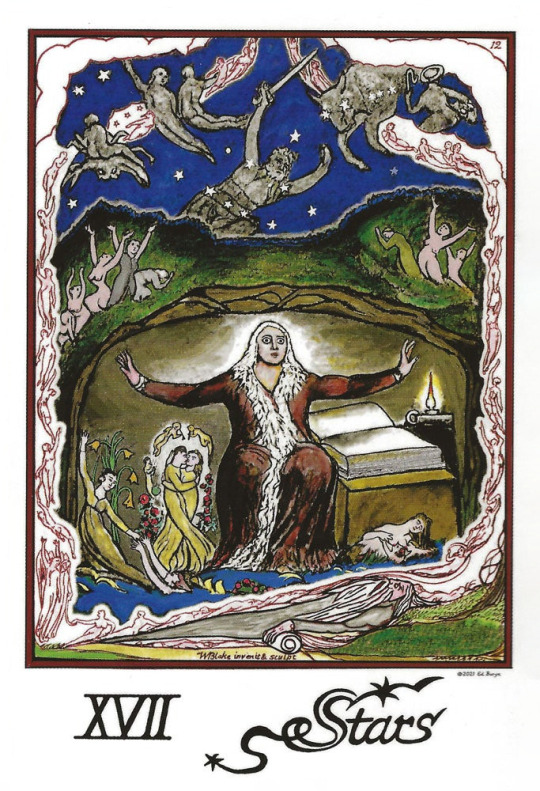
Stars. Art by Ed Buryn, from The William Blake Tarot of the Creative Imagination.
Stars corresponds to the Star in conventional Tarot. The light of the astral intelligences reveals the path once again; the worst of the darkness is over. The soul's inner eye now opens to the grandeur of eternity's firmament. This card depicts the poet John Milton (whose epic Paradise Lost starred and made Satan famous at the time) communing with the constellations from his underground bower of poetry. Although Milton in his old age is completely blind and subterranean, his mind sees and communicates perfectly with the divine energies of the universe. With his arms and fingertips upraised as if absorbing energy, he glows in gnostic ecstasy.
At his left (intellectual) arm is his book of knowledge and lamp of imagination; while at his right are the spirits of herbs and flowers, as well as symbols of human love. At the bottom left, lilies and roses are personified by two pairs of figures: in one, a hovering woman resurrects another from the earth; and a dancing couple embrace beneath an arch of baby angels, signifying perfect love. Underneath the book, a reclining mother nurses her twins. All these figures symbolize and express his inner vision as he speaks his poetic prophecies. By contrast, above him on the surface we see many other people beseeching the stars, but being spiritually blind they can only wail in frustration. Without inspiration, they fail to understand that what they desire from the stars is within them, and not beyond reach above them.
This scene illustrates the final lines of Milton's Il Penseroso:
And may at last my weary age
Find out the peaceful hermitage
The Hairy Gown and Mossy Cell
Where I may sit and rightly spell
Of every Star that Heaven doth shew
And every Herb that sips the dew
Till old experience do attain
To something like Prophetic strain
When Blake painted this picture, he too was approaching old age, and so it can be seen as a psychic self-portrait showing Blake in his own cave of creation, filled with love and writing inspired books of prophecy, while his contemporaries seek but fail to grasp his vision.
In the border below, another aged figure about to awaken. This is the biblical Job represented as sleeping Humanity, with his hand resting on a scroll of inspiration. Streams of angels urge him to open his inner eyes and soar together with them, weaving through the constellations, upward into inspiring visions of eternity.
KEYWORDS: SPIRITUAL REGENERATION • ENDLESS INSPIRATION • MULTIDIMENSIONAL PERCEPTION • CLAIRVOYANCE • NATURE WORSHIP • PUBLIC RECOGNITION • SELF-ESTEEM • ALTRUISTIC IMPULSES AND DESIRES • LIVING YOUR OWN VALUES •
The inspiration of the night sky is heaven enough for many star-struck seekers, who are content to stay here. For those whose opened eyes can accept the vision of even more...
#Ed Buryn#The William Blake Tarot of the Creative Imagination#The Star#Major Arcana#Tarot#William Blake
16 notes
·
View notes
Text
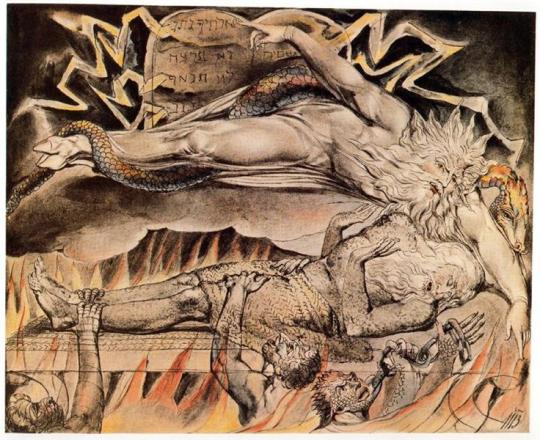
Title: Illustration to Book of Job
Artist: William Blake
Style: Symbolism
Genre: Illustration
45 notes
·
View notes
Photo

artist-blake: Illustration to Book of Job, William Blake
4 notes
·
View notes
Photo

William Blake, Behemoth and Leviathan, 1806, preliminary watercolor for Illustrations of The Book of Job.
16 notes
·
View notes
Photo

MWW Artwork of the Day (5/22/22)
William Blake (British, 1757-1827)
The Ghost of Samuel Appearing to Saul (c. 1800)
Pen and ink with watercolor over graphite, 32 x 34.4 cm.
National Gallery, Washington DC (Rosenwald Collection)
The biblical source for this is 1 Samuel 28:3-25, though Blake seems to be drawing on the 18th c. literary embellishments of the text rather than the original itself.
Several MWW galleries are devoted to Blake:
* William Blake -- The Visionary
* Blake's 'Book of Job' & Illustrations of His Own Poetry
* Dante Illustrated I: William Blake & Salvador Dali
2 notes
·
View notes
Text

Behemoth and Leviathan (1806) by William Blake; a preliminary watercolor for Illustrations of the Book of Job
1 note
·
View note
Text
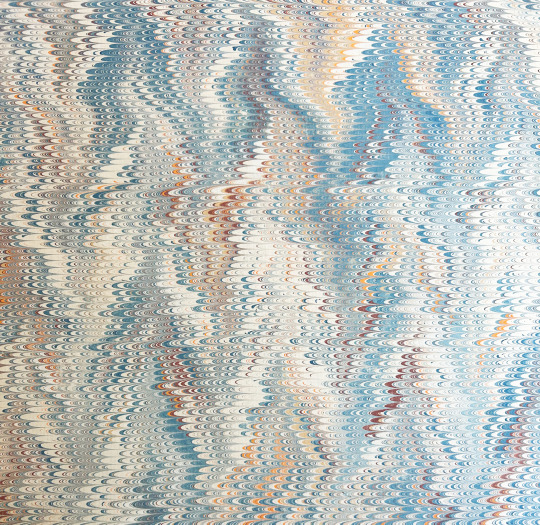





Marbled Monday
We return to Trianon Press's publications of William Blake's works this week, this time taking a look at William Blake's Illustrations of the Book of Job. It is similar to other Trianon Press works we have shared, with a leather and marbled paper half-binding. These two volumes slide into a single slipcase to protect them, which is part of the reason the marbling is in such good shape. These are part of a set with a group of colored plates of Blake's illustrations for the Book of Job that comes in its very own slipcase.
The marbling is a nonpareil pattern, one of the most foundational patterns in marbling. Nonpareil uses usually a stone or Turkish pattern base followed by a gelgit (zigzag) pattern that is ultimately combed to create the small lines or arches seen in the final pattern. This example uses shades of blue and tan to create the pattern.
View more posts about the Trianon Press.
View more Marbled Monday posts.
-- Alice, Special Collections Department Manager
#Marbled Monday#Trianon Press#William Blake#Book of Job#nonpareil pattern#marbling#paper marbling#marbled paper#illustrations#gitgel
40 notes
·
View notes
Text






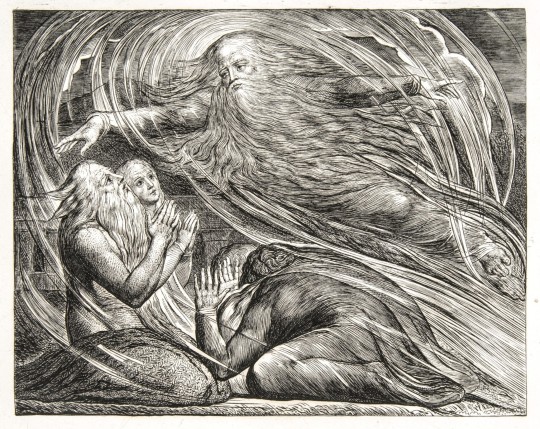

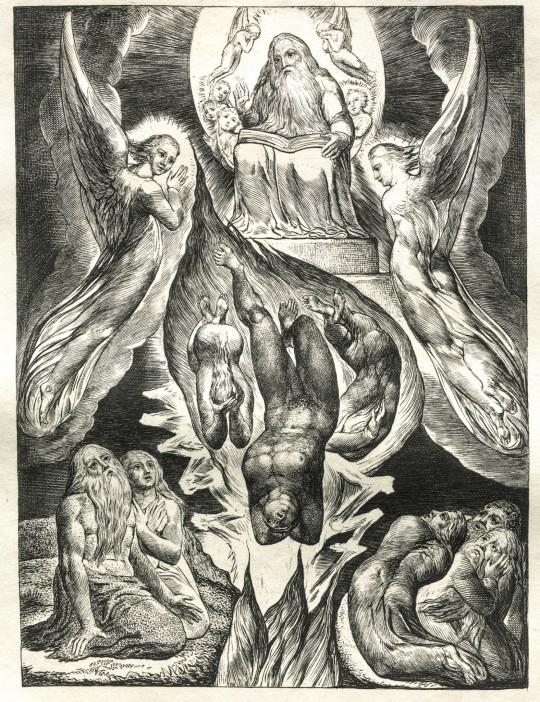

"Illustrations of The Book of Job, Invented & Engraved by William Blake" (See notes for more details.)
#william blake#best checkers buddy in the world#literature#art history#illustration#god#devil#bible#satan#faith#religion#spirituality#surreal#lit#graphic design#horror#vintage#art#print#books#👽
300 notes
·
View notes
Photo

John Linnell - Selfportrait - ca. 1860
oil on canvas, Height: 91.1 cm (35.8 in) Edit this at Wikidata; Width: 70.2 cm (27.6 in)
The National Portrait Gallery (NPG) is an art gallery in London, UK
John Linnell (16 June 1792 – 20 January 1882) was an English engraver, and portrait and landscape painter. He was a naturalist and a rival to the artist John Constable. He had a taste for Northern European art of the Renaissance, particularly Albrecht Dürer. He also associated with the amateur artist Edward Thomas Daniell, and with William Blake, to whom he introduced the painter and writer Samuel Palmer and others of the Ancients.
John Linnell was born in Bloomsbury, London on 16 June 1792. where his father was a carver and gilder. He was in contact with artists from an early age, and by the age of ten was drawing and selling portraits in chalk and pencil. His first art teacher was the American-born artist Benjamin West, and he spent a year in the house of the painter John Varley, where William Hunt and William Mulready were also pupils, and made the acquaintance of Shelley, Godwin and others. In 1805 he was admitted to study at the Royal Academy, where he obtained medals for drawing, modelling and sculpture. He was trained as an engraver, and executed a transcript of Varley's "Burial of Saul."
In 1808, the 16-year-old Linnell moved into Mulready's house, whose wife had accused him of infidelity with both other women and boys. Linnell's association with Mulready may have caused the breakup of Mulready's marriage.
In later life Linnell occupied himself with the burin, publishing, in 1833, a series of outlines from Michelangelo's frescoes in the Sistine Chapel, and, in 1840, superintending the issue of a selection of plates from the pictures in Buckingham Palace, one of them, a Titian landscape, which he engraved in mezzotint. At first he supported himself mainly by miniature painting and execution of larger portraits, such as the likenesses of Mulready, Richard Whately, Peel and Thomas Carlyle. Several of his portraits he engraved in line and mezzotint.
He painted many subjects like the "St John Preaching," the "Covenant of Abraham," and the "Journey to Emmaus," in which, while the landscape is usually prominent the figures are of sufficient importance to supply the title of the work. But it is mainly in connexion with paintings of pure landscapes that his name is known. His works commonly deal with some scene of typical uneventful English landscape, which is made impressive by a gorgeous effect of sunrise or sunset. They are full of true poetic feeling, and are rich and glowing in colour.
Linnell commanded large prices for his pictures, and about 1850 he purchased a property at Redhill, Surrey, where he lived till his death on 20 January 1882, painting with unabated powers until within the last few years of his life. He devoted himself to painting landscapes notably of the North Downs and Kentish Weald. His leisure was occupied with a study of the Bible in the original, and he published several pamphlets and treatises of Biblical criticism. Linnell was one of the best friends and kindest patrons of William Blake. He gave him the two largest commissions he received for single series of designs—£150 for drawings and engravings of The Inventions to the Book of Job, and a like sum for those illustrative of Dante Aligheri.
He was a friend of the painter Edward Thomas Daniell. A blue plaque commemorates Linnell at Old Wyldes' at North End, Hampstead. The plaque mentions that William Blake stayed with Linnell as his guest.
16 notes
·
View notes
Photo

William Blake, November 28, 1757 / 2021
(image: Illustrations of the book of Job. Invented and engraved by William Blake, Published by William Blake, March, 1826. Yale University Library, Beinecke Rare Book and Manuscript Library, New Haven, CT)
#art#poetry#engraving#illustration#book#cover#book cover#william blake#birthday anniversary#yale university library#beinecke rare book and manuscript library#1750s#1820s#2020s
29 notes
·
View notes
Photo

Thy Sons & Thy Daughters Were Eating and Drinking Wine...(etc.), from Illustrations of the Book of Job, William Blake, 1825, Brooklyn Museum: European Art
Size: 8 5/16 x 6 7/16 in. (21.1 x 16.3 cm)
Medium: Engraving
https://www.brooklynmuseum.org/opencollection/objects/158145
23 notes
·
View notes
Text

Title: Illustration to Book of Job
Artist: William Blake
Style: Symbolism
Genre: Illustration
45 notes
·
View notes